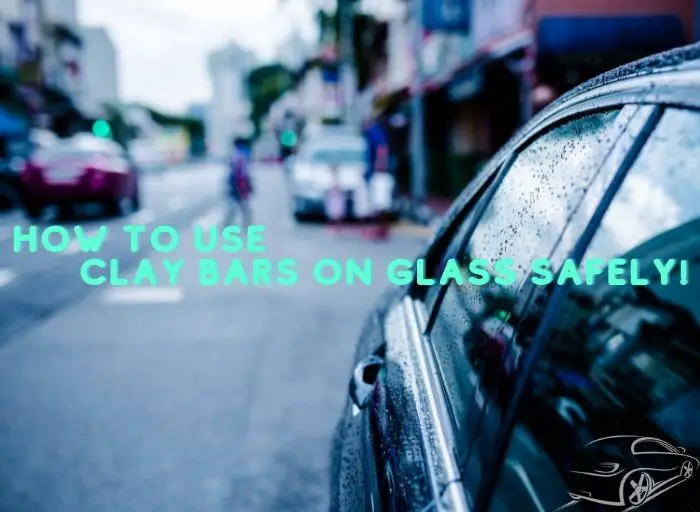
In the past, detailing and cleansing glass surfaces was a painstaking task that required plenty of elbow grease, rinses, and mild acids. Today’s glass cleaners make it easy to get the job done swiftly and safely. One way to say goodbye to streaks is with clay clays bars. How to use a clay bar on glass safely? In this blog, I’ll explain how clay bars work on glass.
Clay bars have been around for decades as detailing products but are now also stocked by most auto accessory shops on account of their aforementioned benefits.
Table of Contents
What Claying Does To The Glass?
In order for any surface to be clayed, a bar with abrasive particles must be used. This causes scratches which are a desirable result in the case of glass because the cracks and scratches increase the usable window surface area. This also serves as a great way to remove any built-up debris on a glass surface and also any visible dirt or grime.
How Do Clay Bars for Glass Differ from Others?
A clay bar specifically designed for glass differs from clay bars intended for other surfaces in a few key aspects:
- Composition: Clay bars designed for glass typically have a different composition compared to clay bars used on paintwork or other surfaces. They are formulated to be softer and less abrasive to avoid scratching the glass while effectively removing contaminants.
- Lubrication: Glass clay bars often require different lubrication than those used on paint. They may recommend specific lubricants or solutions suitable for glass to ensure smooth gliding and prevent any potential damage.
- Density: Glass clay bars tend to be denser and less pliable than those used on paint. This helps them effectively remove stubborn contaminants from the glass surface without deforming or breaking apart easily.
- Contaminant removal: Clay bars designed for glass are optimized to remove contaminants commonly found on glass surfaces, such as road grime, water spots, mineral deposits, and insect remains. They may have a slightly more aggressive formulation compared to clay bars for paint, as glass can typically withstand more aggressive cleaning.
How to Use a Clay Bar on Glass Safely
What You Need:
- Clay bar
- Lubricant
- Microfiber towels
Step-by-Step Guide to Using a Clay Bar on Glass Safely

Step 1: Wash the glass
Start by washing the glass surface thoroughly with a mild automotive glass cleaner and a microfiber cloth. This will remove any loose dirt or debris from the surface and make the clay bar process more effective.
Step 2: Divide the clay bar
Take the clay bar and divide it into small, manageable sections. This will make it easier to work with and ensure fresh clay is available as you progress.
Step 3: Apply lubricant
Spray a generous amount of the recommended lubricant onto the glass surface. The lubricant will create a slick barrier between the clay bar and the glass, reducing friction and preventing scratches.
Step 4: Begin clay bar application
Take one of the divided clay bar sections and flatten it into a pancake shape. Gently glide the clay bar across the lubricated glass surface using light to medium pressure. Use straight-line motions or small circular motions, whichever you prefer.
Step 5: Feel for contamination
As you glide the clay bar, you may feel some resistance or roughness. This indicates the presence of contamination on the glass surface. Continue working the clay bar on those areas until the surface feels smooth and the resistance diminishes.
Step 6: Wipe off the residue
After treating a small section, use a clean microfiber towel to wipe off any residue left by the clay bar and lubricant. This will reveal the cleaned glass surface underneath. Inspect the area to ensure that the contaminants have been effectively removed.
Step 7: Repeat the process
Continue steps 4 to 7, working in small sections at a time until you have treated the entire glass surface. Remember to periodically knead and fold the clay bar to expose a fresh, clean surface for optimal performance.
Step 8: Final wipe-down
Once you have completed the clay bar treatment on the glass, wipe down the entire surface with a clean microfiber towel to remove any remaining residue. This will leave the glass smooth and ready for further detailing if desired.
Step 9: Post-treatment care
After using the clay bar, it’s recommended to apply a glass cleaner or a glass sealant further to enhance the clarity and protection of the glass surface. Follow the product instructions for the specific glass cleaner or sealant you choose.
Check out this video for more detail!
Is Claying Glass Surfaces On Your Car Safe?
If you’re looking for how best to clean car glass, you’ve come to the right place. I use clay bars in my own detailing regimen and can say that cleaning glass this way is safe as long as you do not leave the clay residue on for too long.
The hazards associated with claying your windshield are offset by the rewards of a soiled surface free of harmful debris and other grime. The greatest risk that you will encounter is marring your glass surface with the clay bar. Take care when removing the protective backing from the hardware cloth clay bar and clean any remnants off the glass surface with a microfiber towel or paper towel before applying it to your windshield.
Check out: How to prevent water spots on your cars!
While some DIYers suggest that glass clays are dangerous, their fears are unfounded. When properly used, clays can actually make your glass safer to use. This is because clays remove particles from the glass surface that can affect visibility while driving and expose drivers to more UV light and glare.
By using clays, you can better ensure that you drive safely and comfortably by increasing your windshield’s transparency.
How To Know If Glass Needs Claying?
There is some debate within the detailing community on whether or not glass needs to be cleansed with a clay bar. Some manufacturers of glass cleaners say that their chemical-based solutions can remove debris from glass surfaces and make them safe to use.
Find out: Best usage of clay bars? Is clay bar worth it?!
While there is certainly some merit to this argument, many detailers continue to clay their car glass to get the best possible results. If you’re wondering how often to clay your car windows, there are some factors that you should consider. If your car is parked under a tree, you may want to clean your car glass more frequently than someone who parks in the garage. Tree sap tends to work its way into the paint and onto the glass, making it a visible problem on both paint and glass.
The same can be said for bugs.
Many people think that the road is littered with bugs, but when you look closer, you’ll notice that many of these craters are full of insects and their remains. These small pieces of debris accumulate quickly on your car’s windshield and can affect driving visibility. You can remove this unsightly material by claying your windows and improving your driving visibility.
How Often To Clay Windshield And Car Windows?
The answer to this question depends largely on your climate and how dirty your car is. If your car is parked outside, it will likely collect more debris than one that is parked inside a garage. Therefore, you may want to clay your car windows sooner rather than later if you live in an area with lots of tree coverage or if it rains frequently.
In my experience, I usually clay my car windshield every 1-2 months.
Check out this video for how to clean your windshield with a clay bar!
Frequently Asked Questions
#1 Will clay bar remove water spots from glass?
Yes, a clay bar can effectively remove water spots from glass surfaces. Water spots are often caused by minerals or impurities present in the water, which can leave behind stubborn deposits on the glass. A clay bar is designed to safely remove these contaminants by gently pulling them from the surface.
#2 Can I clay bar windshield?
Yes, you can use a clay bar on a windshield. Clay barring the windshield can effectively remove contaminants like road grime, bug splatter, tar, and other stubborn substances that may accumulate on the glass surface over time.
You can follow the steps above to do it right.
#3 Can a clay bar be used on all types of glass surfaces?
Yes, a clay bar can generally be used on most glass surfaces, including automotive glass. However, it’s important to consider the specific recommendations provided by the clay bar manufacturer. Some glass surfaces, such as those with delicate coatings or aftermarket tinting, may require more caution or alternative cleaning methods to avoid potential damage.
#4 Can I reuse a clay bar?
Yes, a clay bar can be reused multiple times, depending on the contamination level and the clay bar’s size. As you use the clay bar, contaminants will accumulate on its surface, making it less effective over time. To maintain its performance, you can periodically fold, knead, or reshape the clay bar to expose a fresh, clean surface. However, eventually, the clay bar will become saturated with contaminants and may need to be replaced.
#5 What lubricant should I use with a clay bar on glass?
Using a lubricant specifically designed for use with a clay bar on glass surfaces is recommended. Some clay bar kits include lubricant, but if not, you can look for a glass-specific lubricant at an automotive supply store.
Alternatively, you can dilute a mild automotive glass cleaner as a lubricant. Avoid using harsh or abrasive chemicals as lubricants, which may damage the glass or affect the clay bar’s performance.
#6 Are there any risks in using a clay bar on glass?
While clay barring glass surfaces is generally safe, there are some risks to be aware of:
- Scratching: If the clay bar or glass surface is contaminated with larger particles like sand or debris, there is a risk of creating scratches during the clay bar process. That’s why we need to clean the glass surface before using the clay bar to minimize this risk.
- Improper technique: Applying excessive pressure or using the clay bar dry can increase the likelihood of scratching the glass.
- Fragile coatings: Glass surfaces with delicate coatings, such as factory-applied tinting or aftermarket treatments, may be more sensitive to aggressive clay bar treatment.
- Pre-existing damage: If the glass already has significant scratches, chips, or cracks, using a clay bar may not be suitable.
Conclusion
Using a clay bar on glass can be a safe and effective way to remove contaminants and restore clarity to the surface. By following the proper technique and taking the necessary precautions, you can achieve satisfying results while minimizing the risk of damage.
Proper care ensures that your glass surfaces can maintain a crystal-clear appearance for years. Whether you clean it on a regular basis or once in a while, claying your windshield is one of the most effective ways to keep it clean and protect it from UV damage.
Further Reading:
Hi everyone, My name is Ollie Barker.
As a seasoned auto expert I have 25 years of experience working in repair and detailing shops. I love to share my tips & tricks to all car lovers, so that’s why I’m here at Automotive Gearz publishing my content, sharing my passion. Also, I’ve been giving my recommendations on which products are the best to have on the market. I always thought it was hard to pick the right part, so hopefully I can make that a bit easier for you.
Hope you enjoy your time on my little blog!







